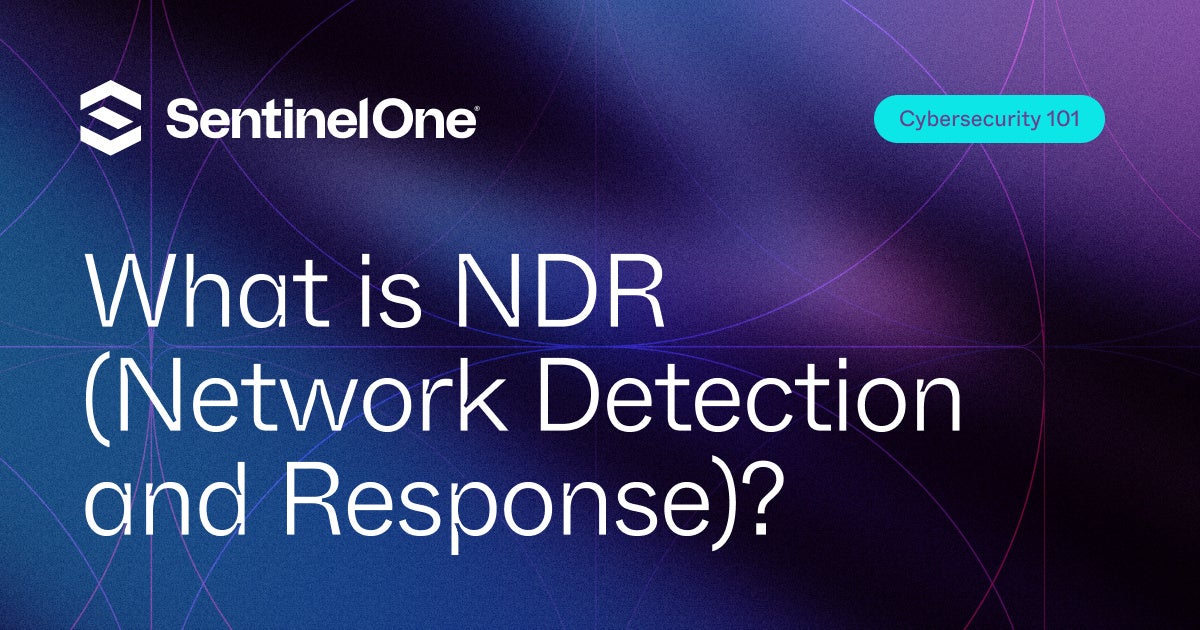Network Detection and Response (NDR) solutions provide visibility and threat detection capabilities for network traffic. This guide explores the features and benefits of NDR, including anomaly detection and incident response.
Learn about the importance of NDR in a comprehensive security strategy and best practices for implementation. Understanding NDR is essential for organizations to safeguard their networks against cyber threats.

The Evolution of Network Detection & Response (NDR)
At first, network traffic was captured by businesses as a way to test the performance levels of their network environments. Once data volumes began to climb across global industries and networks, the capability evolved as a resource for cyber defense purposes.
Before it was known as network detection and response, the technology for monitoring network traffic was first called network traffic analysis (NTA). Though NTA is still a considerable part of today’s network security and security operations center (SOC) practices, it has greatly expanded to capture all aspects of network detection and security.
Nowadays, NDR solutions like SentinelOne’s Singularity™ Endpoint are a combination of sophisticated behavioral analytics, artificial intelligence (AI) and machine learning (ML), and cloud technologies. All of these moving parts contribute to the modern NDR solution, which is a popular choice for organizations looking to improve their detection capabilities, identify risk levels for incoming threats, and automate tasks related to investigative analysis and telemetry so that security professionals can focus on triage processes and threat response.
How Does Network Detection & Response (NDR) Work?
Network detection and response solutions work by continuously ingesting and correlating raw network traffic and activity across an organization’s networks. Data is collected from the perimeter of the network to capture north-south traffic, as well as from sensors within the network to capture east-west traffic.
A robust NDR leverages AI and ML algorithms to develop a baseline understanding of normal or typical network traffic for the organization of which is used to catch malicious activity that is out of the ordinary. AI and ML is also used to model adversary tactics, techniques, and procedures (TTPs), mapped in relation to the MITRE ATT&CK framework in order to detect threat actor’s behaviors with precision.
Security teams also use NDRs for end-to-end forensics of attack timelines, showing initial data breach, lateral movement, and other malicious activities taken, before it triggers automatic prevention and mitigation actions and workflows. Since NDR solutions produce such high-fidelity data and can correlate context, they drastically reduce the overall time and effort spent on investigations. NDR solutions will most commonly revolve around the following key techniques:
Deep & Machine Learning
NDR solutions leverage both machine learning (ML) to produce accurate predictions, which can lead to detection of unknown threats within a network. Often, ML works in conjunction with behavioral analytic capabilities to support security teams with identifying indicators of compromise before they can become full-blown cyber incidents. Machine learning in NDR solutions also enables faster triage and mitigative actions as they continuously weigh incoming, potential threats based on real-world scenarios.
Deep learning is another component of typical NDR solutions. It is a form of ML that uses artificial neural networks to augment the NDR’s capabilities. Deep learning models help security analysts interpret the data so they can uncover the unknown threats lurking within a system.
Statistical Analysis
Using statistical and heuristic techniques, NDR solutions can track network traffic patterns and data against predetermined system ‘norms’ in order to spot signs of breach and compromise. Statistical analysis works by measuring typical/normal traffic usage as a baseline and then compares incoming traffic against it. Suspicious traffic that falls outside the normal ranges and thresholds are then identified for triage.
Threat Intelligence Feeds
NDRs can be trained to work off of threat intelligence data streams that contain information on existing and identified cyber threats. These data feeds augment the NDR solution’s ability to alert on known threats quickly, provide additional contextualization, and help prioritize the risk levels of found anomalies. Threat intelligence feeds do need to be curated and managed carefully though, so that the data is up-to-date and relevant.
Gartner MQ: Endpoint
See why SentinelOne has been named a Leader four years in a row in the Gartner® Magic Quadrant™ for Endpoint Protection Platforms.
Read Report
How Businesses Use Network Detection & Response (NDR)
As distributed networks continue to grow, signature-based security tools like legacy SIEMs, anti-virus (AV), intrusion detection systems (IDS), and intrusion prevention systems (IPS) are not enough to stay ahead of modern cybercriminals. Most threats nowadays have no previous signature, meaning security teams need more to be able to detect and counter cyberattacks. Leveraging leading technologies such as AI, ML, and behavioral analytics, advanced NDR solutions can provide organizations with better protection across their cloud and on-premises environments.
Here are the top business reasons why modern organizations are moving towards employing NDR solutions in their long-term security strategies:
Continuous Threat Visibility
With an NDR solution, security teams are able to see threats from across the network before they can move laterally and cause severe damage. The visibility is also continuous across all users, devices, and technologies connected to the network giving security teams the ultimate bird’s eye view of the networks under protection.
Attack Visualization
NDRs enable security teams with intrusion blueprints, meaning they can see a detailed threat timeline across the entire network in order to quickly scope out the attack and prioritize actions and resources. Since NDRs filter out low-fidelity and unimportant alerts, they can more accurately detect various attack lifecycle phases including persistence, privilege escalation, credential access, lateral movement, data exfiltration, and control and command (C2) actions.
Real-Time Intrusion Detection
Through AI and ML, NDR solutions can operate in real-time, detecting and stopping cyber threats at machine speed. These solutions are capable of providing automatic responses to indicators of compromise through native controls, shutting down the attack before it can spread.
Alert Management
Legacy security solutions are prone to producing mass amounts of alerts and notifications, leading to security analyst burnout and missed detections. An NDR solution can help reduce the number of false positives and ‘noise’, allowing analysts to redirect their time on stopping intrusions and applying proactive strategies.
Protect Your Endpoint
See how AI-powered endpoint security from SentinelOne can help you prevent, detect, and respond to cyber threats in real time.
Get a DemoConclusion
Traditional threat detection tools that rely on signature-based methods and known indicators of compromise are no longer enough to stop modern cyber attackers. Tools such as legacy anti-virus, intrusion detection and prevention systems (IDPSs), and some firewalls are limited in effectiveness now that most threats are new, emerging, and without pre-identified signatures. Threats such as ransomware, advanced persistent threats (APTs), business email compromise (BEC), and more are able to bypass these legacy solutions.
As organizations move towards network detection and response solutions for their use of artificial intelligence, machine learning, and behavioral analytics, they can stay steps ahead of sophisticated threat actors and build up a more proactive stance in the long term with a comprehensive solution like Singularity™ Endpoint platform. NDRs are designed to detect threats by comparing huge amounts of raw network traffic and data against normal behavior through continuous analysis. Since they help security teams facilitate faster and more accurate responses while supporting effective threat hunting, NDRs have become a widely trusted solution for today’s organizations.
Network Detection and Response FAQs
Network Detection and Response is a security solution that watches network traffic for unusual patterns, anomalies, or known attack behaviors. It inspects packets, flow records, and metadata across on-prem, cloud, and hybrid environments.
When it spots a threat—like lateral movement or data exfiltration—it raises an alert and offers context to help you investigate and contain incidents fast.
An NDR tool taps into network taps, span ports, or packet brokers to collect raw traffic and flow data. It applies behavioral analytics, threat intelligence, and sometimes machine learning to find deviations—unapproved protocols, odd scanning, or command-and-control calls.
Once a suspicious event is flagged, playbooks guide triage, threat hunting, and automated or manual containment actions.
Modern networks are complex: microsegmented clouds, remote users, and encrypted flows can hide threats from endpoint tools alone. NDR bridges gaps by tracking traffic across segments and protocols.
That means you catch stealthy intruders moving laterally, encrypted malware downloads, or rogue devices—so you don’t rely solely on logs or endpoint sensors to uncover every threat.
With NDR, you gain: deeper visibility into internal traffic, rapid detection of stealthy attacks, and richer context for investigations. You’ll see lateral moves and encrypted threats that evade EDR. Automated alerts and response playbooks speed up containment.
Plus, continuous monitoring helps you validate network segmentation and compliance, reducing dwell time and limiting breach impact.
EDR focuses on endpoint behaviors—processes, files, and registry changes on hosts. SIEM ingests logs and events from across your stack for correlation and reporting. XDR unifies telemetry from endpoints, network, cloud, and identity into one console.
NDR zeroes in on network traffic itself, filling blind spots in encrypted or unmanaged segments. Together, they give layered detection and response.
NDR tools catch lateral movement, brute-force or unauthorized access attempts, DNS tunneling, command-and-control callbacks, data exfiltration, ARP spoofing, and anomalous protocol use. They also spot unusual traffic volumes, hidden beaconing, and policy violations—like unsecured shadow IT services—so you uncover both automated attacks and manual intrusions that slip past firewalls.
When NDR flags suspicious traffic, it provides packet captures, session details, and threat context—IP addresses, process names, or user accounts involved. Automated playbooks can block malicious IPs, quarantine infected segments, or throttle suspect flows. Analysts use live flow graphs and forensic timelines to trace attack paths, making it faster to contain, remediate, and restore normal traffic.
Choose an NDR with high-fidelity packet capture, encrypted traffic analysis, and support for cloud and container networks. Look for behavioral analytics that learn your baselines, built-in threat intelligence feeds, and seamless integration with your SOAR or SIEM.
Automated response workflows, customizable detections, and detailed forensics dashboards help your team hunt threats and act swiftly.
SentinelOne’s NDR can automatically isolate and quarantine network traffic threats by analyzing east-west and north-south traffic behaviors by using AI. It uses it global threat telemetry data to spot anomalies. When it detects an incident, Singularity XDR can take action, remediate vulnerabilities, and initiate rollbacks where needed.
You can also enrich threat investigations by using SentinelOne’s SOAR services with its NDR support.

